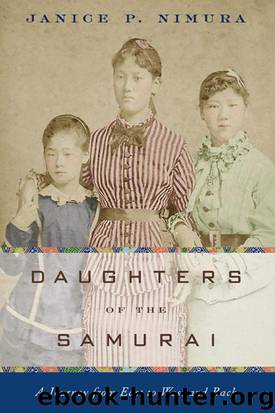Daughters of the Samurai: A Journey From East to West and Back by Janice P. Nimura

Author:Janice P. Nimura [Nimura, Janice P.]
Language: eng
Format: epub
Tags: Asia, History, Japan, Nonfiction, Retail
ISBN: 9780393248241
Google: pgmdBAAAQBAJ
Barnesnoble:
Publisher: W. W. Norton & Company
Published: 2015-05-04T04:00:00+00:00
BY THE END of that first spring, Ume despaired of ever repaying the debt she owed Japan. On bad days, she expressed her unhappiness in the same bleak terms Sutematsu had used before her decision to marry. “If I thought that by my dying I could elevate these daughters of Japan, I should be glad to do so,” she wrote to Mrs. Lanman. “Is it not easier to give up life, and see a work done than to blindly grope and try, and see the end unattained, and fret and worry over impossibilities?”
For Ume, the months following Sutematsu’s engagement proved the grimmest. Stranded in the Azabu farmhouse, “devoured with fleas” and tormented by mosquitoes, Ume tried to make herself useful: serving tea to visitors, tidying her room, studying Japanese, and scolding her seven younger siblings into submission. She took solace in her precious piano, purchased for her by the Lanmans with the last of her stipend. Having survived its journey from Washington mostly unscathed, it now dwarfed the Tsuda family’s small parlor.
In Georgetown, Ume had been a daughter of the elite; in Tokyo, her family’s social standing was more ambiguous. Sen Tsuda, Ume’s father, had pursued an eclectic assortment of progressive ideas during Ume’s years in America. He had traveled to the Vienna Exposition in 1873, and in the years following his return he helped found a missionary school for girls, a school for the deaf and blind, and a school of agriculture. He was a member of the intellectual club known as the Meirokusha, where he fraternized with some of the brightest minds of the Meiji leadership. He enjoyed a brief commercial success with the “Tsuda rope,” a pollination technique imported from Holland, involving a woolen rope painted with honey to brush against ears of grain. He arranged for a commemorative tree to be planted in honor of President Grant’s visit.
But to his samurai peers, Tsuda’s enthusiasm for farming seemed déclassé, and his embrace of American-style equality extreme: he had even gone so far as to change his official status from samurai to heimin, or commoner. His fervent embrace of Christianity likewise marked him as an eccentric. By the time of Ume’s return, with the national appetite for foreign ways fading, her father’s influence was in decline. And though she was comforted by his religious choice, Ume was appalled to discover that shortly before his conversion, Tsuda had fathered a child with a servant—perfectly acceptable by samurai standards but profoundly shocking to an upper-middle-class daughter of Georgetown. As a mentor and patron, then, Ume found her father less than ideal, especially in comparison with Shige’s wealthy businessman brother or Sutematsu’s powerful fiancé—both men paragons of cosmopolitan elegance.
Shige, always the most maternal of the trio, worried about Ume’s isolation. She sent a colleague from the music school to tune Ume’s piano, and shared her concerns in letters to America. “Mrs. Lanman she misses you, and your love, your home, your country, more than any of us,” she wrote to Georgetown.
Download
This site does not store any files on its server. We only index and link to content provided by other sites. Please contact the content providers to delete copyright contents if any and email us, we'll remove relevant links or contents immediately.
| Central Asia | Southeast Asia |
| China | Hong Kong |
| India | Japan |
| Korea | Pakistan |
| Philippines | Russia |
The Sympathizer by Viet Thanh Nguyen(4307)
The Rape of Nanking by Iris Chang(4140)
World without end by Ken Follett(3432)
Ants Among Elephants by Sujatha Gidla(3417)
Blood and Sand by Alex Von Tunzelmann(3140)
Japanese Design by Patricia J. Graham(3112)
City of Djinns: a year in Delhi by William Dalrymple(2516)
The Queen of Nothing by Holly Black(2499)
Foreign Devils on the Silk Road: The Search for the Lost Treasures of Central Asia by Peter Hopkirk(2434)
India's Ancient Past by R.S. Sharma(2417)
Inglorious Empire by Shashi Tharoor(2396)
Tokyo by Rob Goss(2390)
In Order to Live: A North Korean Girl's Journey to Freedom by Yeonmi Park(2348)
India's biggest cover-up by Dhar Anuj(2319)
Tokyo Geek's Guide: Manga, Anime, Gaming, Cosplay, Toys, Idols & More - The Ultimate Guide to Japan's Otaku Culture by Simone Gianni(2316)
The Great Game: On Secret Service in High Asia by Peter Hopkirk(2305)
Goodbye Madame Butterfly(2208)
Batik by Rudolf Smend(2127)
Living Silence in Burma by Christina Fink(2038)
